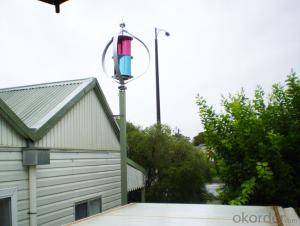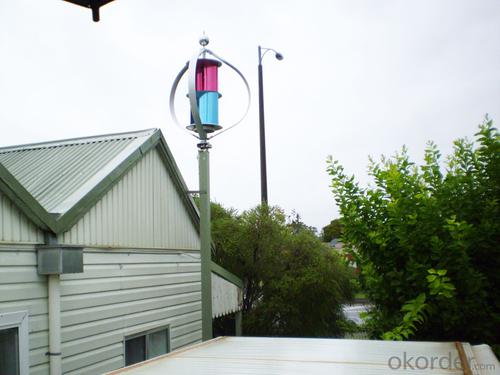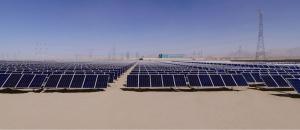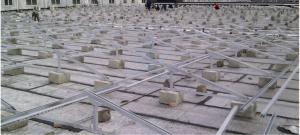Magnetic Levitation Wind Turbine Series CXF
- Loading Port:
- Shekou
- Payment Terms:
- TT or LC
- Min Order Qty:
- 10 set
- Supply Capability:
- 1000 set/month
OKorder Service Pledge
OKorder Financial Service
You Might Also Like
1.Structure of Magnetic Levitation Wind Turbine Series CXF
As one of the renweable energies , wind power is considered to be the important supplement for generating electricity. The maglev wind turbines undergoes a continuous improvement process, which incorporates exterior design, utility design, electrical engineering, dynamic engineering, power mechanics, aviation air engineering, wind tunnel testing, lightening protection, computer simulation techniques and other multiple subjects.
2.Main features of Magnetic Levitation Wind Turbine Series CXF
Magnetic levitation technology
Independent of the direction of the wind
Startup at low wind speed of 1m/s
Higher efficiency compared to traditional HAWT
Works even in turbulence
Visually pleasing appearance
Turbine construction is resistant to gale 60m/s (132MPH)
Robustness and adaptation to all possible environmental conditions thanks to material of aluminum alloy or stainless steel
Design life: at least 20 years
Noise: Tested by China National Machinery Quality Inspection Centre at 12m/s: <40db
3.Magnetic Levitation Wind Turbine Series CXF Specification
Items | CXF300 | CXF600 | CXF1000 | CXF3000-Ⅰ | CXF3000-Ⅱ |
Rated power | 300W | 600W | 1000W | 3000W | 3000W |
Dimension (Height/Diameter) | Ø1080/1240 | Ø1320/1540 | Ø2200/2400 | 3530/Ø3600 | Ø4160/4570 |
Weight | 27 | 50 kg | 180 kg | 415KG | 680 kg |
Blade material | Aluminum Alloy | Aluminum Alloy | Aluminum Alloy | Aluminum Alloy | Aluminum Alloy |
Blade quantity | 3 | 3 | 3 | 3 | 3 |
Swept area | 0.76 | 1.27 | 3.6 | 7.02 | 7.72 |
Min starting wind speed | 1m/s | 1.3m/s | 1.5 m/s | 1.5m/s | 1.5m/s |
Cut-in wind speed | 2.7 m/s | 2 7m/s | 3.5m/s | 3.5m/s | 3.5m/s |
Rated wind speed | 12m/s | 12m/s | 13m/s | 13m/s | 13m/s |
Cut-off wind speed | 15m/s | 15m/s | 15m/s | 15m/s | 15m/s |
Survival wind speed | 65m/s | 65m/s | 60m/s | 60m/s | 60m/s |
Generator type | AC,3Phases | AC,3Phases | AC,3Phases | AC,3Phases | AC,3Phases |
Controller Output Voltage | 12V/24V | 24V/48V | 48V | 48V | 96V |
Controller Braking System | 3-phase short circuit by NFB brake | 3-phase short circuit by NFB brake | 3-phase short circuit by NFB brake | 3-phase short circuit by NFB brake | 3-phase short circuit by NFB brake |
Ambient Temperature | -40~50 ℃ | -40~50 ℃ | -40~50 ℃ | -40~50 ℃ | -40~50 ℃ |
Noise | Noisy from National Machinery Quality Inspection Centre at 12m/s : <40db | ||||
4. Magnetic Levitation Wind Turbine Series CXF Images

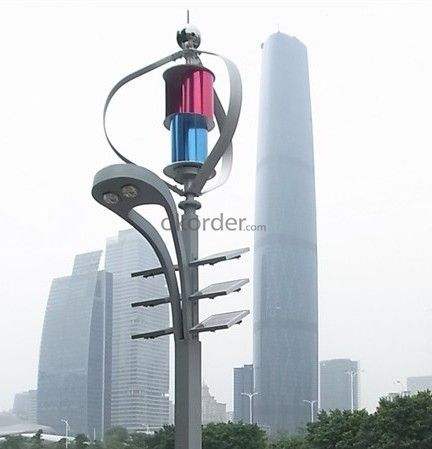
5. FAQ
Q1: Can I change the color of the blade?
Re: Surely you can customize the color of blade.
Q2: Is it difiicult to instal the wind turbine?
Re: It is easy for the installation, you can consult the mannual.
- Q: Can solar chargers be used for charging power tools?
- Yes, solar chargers can be used for charging power tools. However, the charging time may vary depending on the power requirements of the specific tool and the capacity of the solar charger. It is important to ensure that the solar charger has sufficient wattage and compatible connectors to charge the power tools effectively.
- Q: Can solar lights be used in all weather conditions?
- Solar lights are designed to be weather-resistant and can typically withstand various weather conditions, including rain, snow, and heat. However, extreme weather conditions such as heavy storms or blizzards might affect the performance and charging capability of solar lights. Therefore, while solar lights are generally suitable for all weather conditions, it is advisable to consider the specific climate and weather patterns of your location before making a purchase.
- Q: Can solar lights be used for illuminating outdoor sports fields?
- Indeed, outdoor sports fields can be illuminated using solar lights. These lights operate solely on solar energy, eliminating the need for electrical connections or power supplies. This makes them particularly advantageous for remote areas or locations where installing electrical infrastructure may pose challenges or incur high costs. The mechanism of solar lights involves absorbing solar energy during the day and storing it in built-in batteries. These batteries then power the lights at night, delivering illumination for outdoor spaces. When it comes to outdoor sports fields, strategic placement of solar lights can provide ample lighting for both players and spectators. However, it is crucial to take into account the specific requirements of the sports field, including its size, layout, and desired lighting levels. Several factors must be considered when utilizing solar lights for illuminating outdoor sports fields. These factors include the number and positioning of the lights, the wattage and brightness of the lights, and the duration of required illumination. To ensure adequate lighting for sporting activities, it may be necessary to install a higher number of lights or employ more powerful solar panels and batteries. Moreover, solar lights present an environmentally friendly alternative as they rely on renewable energy and do not emit greenhouse gases. By utilizing solar lights, sports facilities can reduce energy consumption and lower operational costs. Nevertheless, it is important to acknowledge that solar lights may have limitations in terms of providing consistent and bright illumination compared to traditional electrical lighting. Weather conditions, shading, and the angle of the solar panels can all impact the performance of solar lights. Therefore, consulting with lighting professionals or engineers is recommended to ensure optimal design and installation when utilizing solar lights for illuminating outdoor sports fields.
- Q: Can solar vacuum tubes be used in conjunction with a heat pump?
- Yes, solar vacuum tubes can be used in conjunction with a heat pump. The solar vacuum tubes can capture solar energy and transfer it to the heat pump, which can then use this energy to heat the desired space or water. This combination can enhance the overall efficiency and effectiveness of the heating system.
- Q: Can solar vacuum tubes be used for solar-powered wastewater treatment?
- Yes, solar vacuum tubes can be used for solar-powered wastewater treatment. These tubes are capable of harnessing solar energy to heat and sterilize wastewater, effectively treating it and making it safe for reuse or discharge.
- Q: Can solar chargers charge outdoor speakers?
- Yes, solar chargers can charge outdoor speakers as long as the speakers have a compatible charging port and the solar charger has enough power output to meet the speaker's charging requirements.
- Q: The world is rich in various resources. Do you know which belongs to renewable resources, which are non renewable resources?
- In addition, if you do not pay attention to protection, arbitrary access, renewable resources may also become non renewable resources. For example, a wild animal, once its living environment is destroyed, reduce the number of species to a certain extent, it is impossible to sustain their reproduction, only dinosaur extinction, is disappearing from the earth. According to statistics, since 1600, there are records of higher animals and plants have been extinct 724. After a rough estimate, 400 years, the living environment of the living area reduced by 90%, species decreased by half, which is due to the decline of tropical rain forests are more serious impact on the loss of species. Therefore, whether it is non renewable resources, renewable resources, we should pay attention to the protection and rational use
- Q: How do solar pumps handle water with high fluoride or chemical content?
- Solar pumps do not have a specific mechanism to handle water with high fluoride or chemical content. However, the filtration system used in solar pumps can help remove some impurities from the water, including certain chemicals and contaminants. It is important to note that the effectiveness of this filtration process may vary depending on the specific chemicals or fluoride levels present in the water. In cases of extremely high levels, additional treatment methods might be necessary to ensure the water is safe for consumption or other purposes.
- Q: Can solar lights be used on boats and RVs?
- Indeed, solar lights have the capability to be utilized on both boats and RVs. In reality, they are quite popular for illuminating these recreational vehicles due to the numerous advantages they offer. Powered by sunlight, solar lights eliminate the need for any external power source or wiring, thus making them a breeze to install and use even in remote areas. Moreover, they are energy-efficient, cost-effective, and environmentally friendly as they harness the renewable energy of the sun. Various types of solar lights, such as string lights, spotlights, lanterns, and deck lights, are available, catering to diverse lighting requirements on boats and RVs. Ultimately, solar lights serve as a practical and efficient lighting solution for these vehicles, enhancing their functionality while mitigating their environmental impact.
- Q: Can solar collectors be used in areas with limited access to training?
- Yes, solar collectors can be used in areas with limited access to training. Solar collectors are relatively simple and can be installed and operated with basic knowledge. Additionally, there are numerous online resources, manuals, and instructional videos available that provide step-by-step guidance on how to install and maintain solar collectors. Therefore, even in areas with limited access to training, individuals can still learn and adopt solar technology for their energy needs.
Send your message to us
Magnetic Levitation Wind Turbine Series CXF
- Loading Port:
- Shekou
- Payment Terms:
- TT or LC
- Min Order Qty:
- 10 set
- Supply Capability:
- 1000 set/month
OKorder Service Pledge
OKorder Financial Service
Similar products
Hot products
Hot Searches
